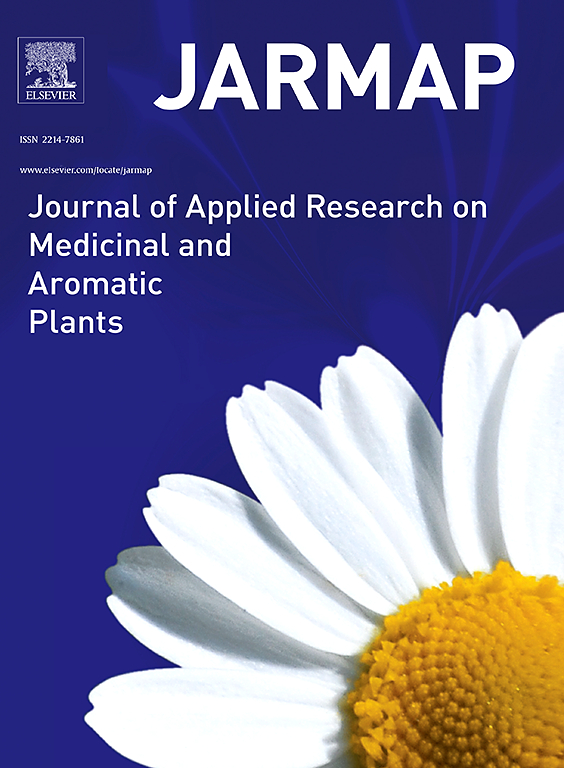Xenia effect enhance pod and seed quality in Gleditsia sinensis
IF 3.6
2区 农林科学
Q1 PLANT SCIENCES
Journal of Applied Research on Medicinal and Aromatic Plants
Pub Date : 2025-05-01
DOI:10.1016/j.jarmap.2025.100644
引用次数: 0
Abstract
Gleditsia sinensis is a tree species with high economic value, but the pairing of male and female trees is often overlooked in its cultivation practices. The fruit quality of G. sinensis under natural pollination tends to be inconsistent, resulting in lower economic value. Therefore, understanding the xenia effects of G. sinensis on fruit and seed quality is crucial for improving their overall quality. In this study, The G. sinensis as the female parent and Gleditsia japonica var. delavayi, Gleditsia japonica, G. sinensis, and Gleditsia fera as male parents for hybridization. By observing and comparing the inflorescence characteristics of different male parents, as well as the fruit set rates, pod phenotypes, and seed yield under various pollination combinations, we found that artificial pollination significantly increased the yield of pods and seeds, and distinct xenia effects were observed in the fruits and seeds of G. sinensis. Through comprehensive evaluation, G. fera was identified as the optimal pollen source for interspecific hybridization with G. sinensis, significantly increasing fruit set rate, saponin content, and seed yield. Pollination with G. japonica resulted in a higher seed abortion rate and poorer seed quality, but significantly increased the amino acid and starch content in the pods. G. delavayi pollen is more inclined to produce high-quality seeds. These findings provide valuable insights for the selection of G. sinensis pollinating trees and the improvement of G. sinensis fruit quality.
Data availability
All data generated in this study are presented within the manuscript. Further information and requests could be directed to the lead contact, Prof. Yang Zhao ([email protected])
Xenia效应提高了皂荚和种子的品质
皂荚是一种具有较高经济价值的树种,但在皂荚的栽培实践中,往往忽略了雌雄树的配对。在自然授粉条件下,白杨果实品质趋于不一致,经济价值较低。因此,了解赤霉素对赤霉素果实和种子品质的影响,对提高赤霉素果实和种子的整体品质具有重要意义。本研究以中国皂荚为雌性亲本,皂荚为雄性亲本,对皂荚变种delavayi、皂荚、中国皂荚和fera皂荚进行杂交。通过观察和比较不同父本的花序特征,以及不同授粉组合下的坐果率、荚果表型和种子产量,我们发现人工授粉显著提高了白杨的荚果和种子产量,并且在白杨的果实和种子中观察到明显的异种效应。通过综合评价,确定fera是与sinensis进行种间杂交的最佳花粉源,可以显著提高坐果率、皂苷含量和种子产量。用粳稻授粉后,籽粒败育率较高,籽粒质量较差,但荚果中氨基酸和淀粉含量显著增加。花粉更倾向于产生优质种子。这些研究结果为中华猕猴桃授粉树种的选择和中华猕猴桃果实品质的改良提供了有价值的见解。数据可得性本研究中产生的所有数据均在论文中列出。进一步的信息和请求可以直接联系首席联系人赵杨教授([email protected])。
本文章由计算机程序翻译,如有差异,请以英文原文为准。
求助全文
约1分钟内获得全文
求助全文
来源期刊

Journal of Applied Research on Medicinal and Aromatic Plants
Pharmacology, Toxicology and Pharmaceutics-Drug Discovery
CiteScore
6.40
自引率
7.70%
发文量
80
审稿时长
41 days
期刊介绍:
JARMAP is a peer reviewed and multidisciplinary communication platform, covering all aspects of the raw material supply chain of medicinal and aromatic plants. JARMAP aims to improve production of tailor made commodities by addressing the various requirements of manufacturers of herbal medicines, herbal teas, seasoning herbs, food and feed supplements and cosmetics. JARMAP covers research on genetic resources, breeding, wild-collection, domestication, propagation, cultivation, phytopathology and plant protection, mechanization, conservation, processing, quality assurance, analytics and economics. JARMAP publishes reviews, original research articles and short communications related to research.
 求助内容:
求助内容: 应助结果提醒方式:
应助结果提醒方式:


